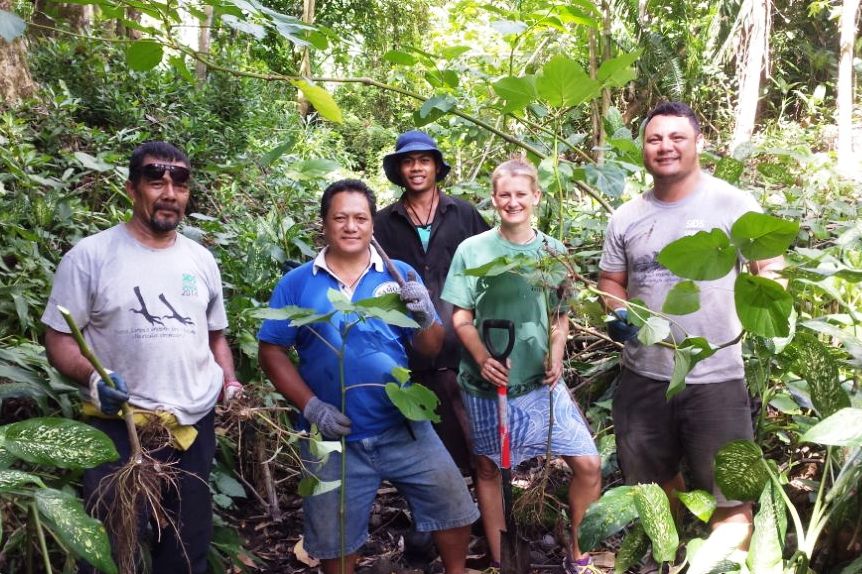
Biodiversity Conservation
While plagiarism may be a sincere form of flattery, this may not be the case for the False Kava (Piper auritum).
This fast growing invasive shrub, looks and feels like the Ava plant which is renowned throughout the Pacific region. It is a noxious weed which competes with other plants and threatens native forests where it is introduced as it quickly forms large thickets and a dense canopy.
The kava or ava is part of the cultural identity for many Pacific islanders. It is grown and nurtured by families and is utilised in traditional ceremonies.
 MNRE and SPREP working together to remove the False Kava plant along the foothill of the
MNRE and SPREP working together to remove the False Kava plant along the foothill of the
Mr Vaea National Reserve. Photo courtesy of James Atherton.
So when this imposter, False Kava, had been sighted in Samoa, the team from the Ministry of Natural Resources & Environment (MNRE) together with volunteers confronted them along the foothill of Mt Vaea National Reserve and started the battle to remove them.
The False Kava is just one of the many invasive species currently being removed by the Mt Vaea National Reserve restoration team. Removing these invasive species and replacing them with native trees is a key objective of a project supported by the Secretariat of the Pacific Regional Environment Programme (SPREP), the United Nations Environment Programme (UNEP) and the Global Environment Facility (GEF).
"These False Kava plants thrive alongside river paths and roads, so when it rains and the rivers flood, the plant is spread downstream to invade new areas," said Mr. Suemalo Talie Foliga, MNRE's Principal National Parks and Reserves Officer.
The Apaula Stream is a popular spot for visitors to the Mt Vaea National Reserve is invaded by the False Kava. Eliminating them from this site will halt its spread but efforts are needed to remove them from further upstream.
"What we observed is that it is really important to remove the whole tree including the roots," said Ms. Anna Bertram, one of the volunteers at the site.
"Pulling them out was easy, especially the young plants. If the roots are left in the soil, new plants will start sprouting and this will continue the problem," adds Ms Bertram.
The restoration effort is a long-term plan for the team from the National Parks and Reserves unit at the Ministry and ongoing monitoring and removal is required to ensure that native plants are given the opportunity to grow.
The Mt Vaea restoration is currently part of the GEF-PAS "Prevention, eradication and control of invasive alien species in the Pacific islands" project which is implemented by UNEP and executed in Samoa by SPREP and MNRE".
This fast growing invasive shrub, looks and feels like the Ava plant which is renowned throughout the Pacific region. It is a noxious weed which competes with other plants and threatens native forests where it is introduced as it quickly forms large thickets and a dense canopy.
The kava or ava is part of the cultural identity for many Pacific islanders. It is grown and nurtured by families and is utilised in traditional ceremonies.
 MNRE and SPREP working together to remove the False Kava plant along the foothill of the
MNRE and SPREP working together to remove the False Kava plant along the foothill of the Mr Vaea National Reserve. Photo courtesy of James Atherton.
The False Kava is just one of the many invasive species currently being removed by the Mt Vaea National Reserve restoration team. Removing these invasive species and replacing them with native trees is a key objective of a project supported by the Secretariat of the Pacific Regional Environment Programme (SPREP), the United Nations Environment Programme (UNEP) and the Global Environment Facility (GEF).
"These False Kava plants thrive alongside river paths and roads, so when it rains and the rivers flood, the plant is spread downstream to invade new areas," said Mr. Suemalo Talie Foliga, MNRE's Principal National Parks and Reserves Officer.
The Apaula Stream is a popular spot for visitors to the Mt Vaea National Reserve is invaded by the False Kava. Eliminating them from this site will halt its spread but efforts are needed to remove them from further upstream.
"What we observed is that it is really important to remove the whole tree including the roots," said Ms. Anna Bertram, one of the volunteers at the site.
"Pulling them out was easy, especially the young plants. If the roots are left in the soil, new plants will start sprouting and this will continue the problem," adds Ms Bertram.
The restoration effort is a long-term plan for the team from the National Parks and Reserves unit at the Ministry and ongoing monitoring and removal is required to ensure that native plants are given the opportunity to grow.
The Mt Vaea restoration is currently part of the GEF-PAS "Prevention, eradication and control of invasive alien species in the Pacific islands" project which is implemented by UNEP and executed in Samoa by SPREP and MNRE".